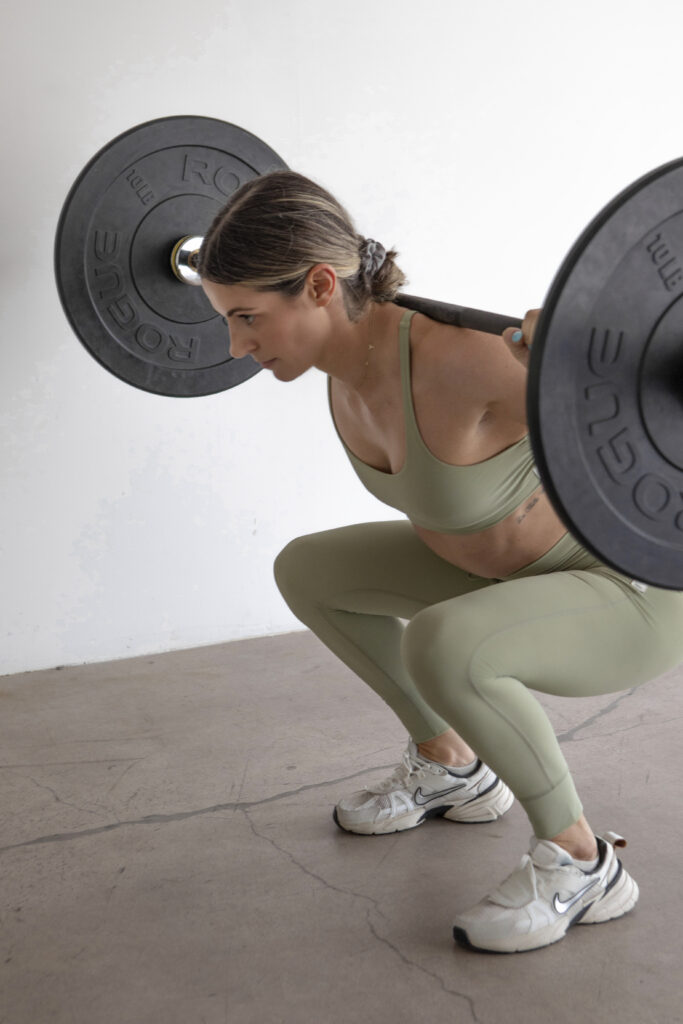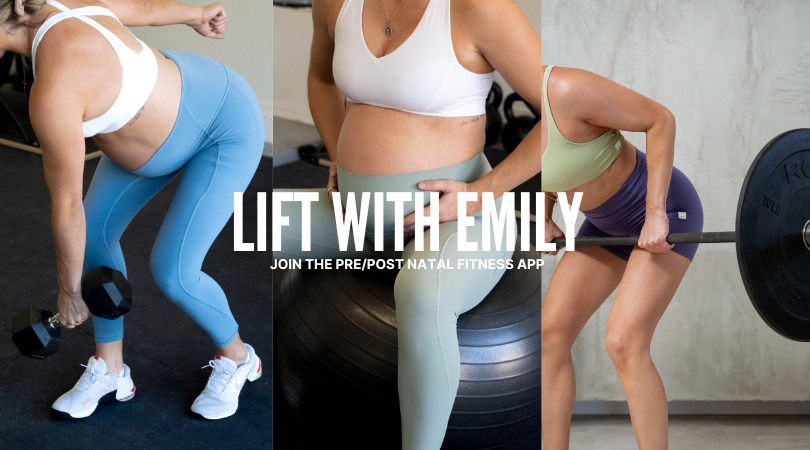Breathing strategies in pregnancy and postpartum are often oversimplified — “Always exhale on exertion” is one of the most common cues. While that cue can be incredibly useful, it’s not the only correct way to breathe during movement. In fact, teaching just one approach can limit both strength development and function — especially when we consider the demands of motherhood, life, and performance.
Let’s break down why that advice exists, when it might be helpful, and why breath holding (yes, even the Valsalva maneuver) isn’t inherently harmful to your pelvic floor.

Why “Exhale on Exertion” Is Commonly Taught
- Exhaling can help cue a pelvic floor and deep core contraction (especially useful early postpartum or when re-learning control).
- It helps regulate intra-abdominal pressure.
- For those experiencing pelvic floor symptoms (leaking, heaviness), this cue can reduce pressure-related symptoms.
It’s a helpful tool for awareness and coordination, especially when rebuilding core-pelvic floor connection. But it’s not the only tool and it’s not always ideal for heavy lifting, dynamic movement, or athletic performance.
What Is the Valsalva Maneuver — and Is It Safe?
- Valsalva = intentional breath hold during exertion, commonly used in heavy lifting to create maximal intra-abdominal pressure and trunk stability.
- This breath-hold increases pressure in the abdomen and that’s not inherently bad.
What matters: how that pressure is managed. If you’re bearing down (pushing pressure down into the pelvic floor), especially with poor positioning or bracing strategies, that’s when it becomes problematic.
But when done well with a strong, reflexive pelvic floor, rib cage positioning, and good pressure management, breath holding can be part of a strong, functional, and safe strategy.
When might a breath hold be useful:
- Lifting a heavy load off the ground
- Performing a maximal – or close to maximal – effort rep (like a 1-5RM squat or deadlift)
- Pushing a stroller up a hill or lifting a car seat awkwardly into the car
In these real-world situations, we often naturally breath hold and that’s okay. The goal isn’t to avoid breath holding, it’s to train your body to handle it.
How to Perform the Valsalva Maneuver Correctly
To perform it properly, begin by setting your ribcage over your pelvis so you’re in a stacked position, not flared or overly tucked. Take a deep, diaphragmatic breath into your ribcage and abdomen, allowing for 360° expansion (into your sides and back, not just belly). Exhale and gently brace your core as if preparing to be punched — this is a firm but not rigid tension, this is also not pushing out or down. As you initiate your lift (like a deadlift or squat), hold your breath and maintain that pressure through the most challenging part of the movement. Once you pass the sticking point or reach the top of the lift, exhale with control and reset.
Key reminders:
- The breath is held to contain pressure, not to force it down or forward
- You should feel grounded, stable, and connected through your trunk. Not like you’re “pushing” through the lift.
Modified Valsalva During Pregnancy or Early Postpartum
During pregnancy and the early postpartum period, breath holding can still be used but it should be adapted to match your body’s current capacity for pressure management. A modified Valsalva is a lighter, more reflexive version of the standard breath hold. You’ll still inhale deeply into your ribcage and abdomen, but with slightly less volume and more awareness. Gently engage your core — think of wrapping or hugging in, rather than bracing forcefully. Then, hold your breath briefly as you perform a challenging. Limit the duration of the breath hold, and focus on maintaining control throughout.
Key adjustments:
- Use only as tolerated. No symptoms like heaviness or bulging. Personally, I found a modified breath hold during deadlifts helped me throughout the entirety of pregnancy but preferred exhaling through exertion for others.
- Focus on short, controlled breath holds, not prolonged effort. You are likely not doing anything in the earlier postpartum period that is pushing you close to your max threshold anyway.
- Keep the pelvic floor responsive, not bearing down. Pay attention to how you feel during and after the movement.
What Bearing Down or Straining Looks Like
Improper breath holding — often described as bearing down or straining — involves pushing pressure downward into the pelvic floor instead of containing it within the trunk. This can happen when the core isn’t managing pressure well, or when someone grips too hard, braces too forcefully, or breathes only into the belly. In this state, the pelvic floor often moves downward instead of lifting, and the abdomen may bulge outward in a dome shape rather than staying firm and evenly pressurized. You might also notice strain in the neck or face, like clenched jaw or holding tension in the throat.
Signs you’re bearing down:
- A sense of pushing downward into the pelvis or rectum.
- Heaviness or pressure in the vaginal area.
- Bulging of the lower belly, especially in one direction (typically straight out).
- Holding breath with visible straining. Red face, clenched teeth, or tension in the throat or neck.
So, What Should You Focus On?
- Understanding different breathing strategies: Exhale on effort, inhale to open space, natural breath holding — all are tools you can use.
- Learning to manage pressure: Can you create tension without bearing down?
- Building a responsive core and pelvic floor: One that adapts to breath, load, and movement.
Final Thoughts:
Breath holding isn’t the enemy. Valsava is a tool, not a rule and when used well it can support the pelvic floor, not harm it. Blanket cues like “always exhale” may be well-intentioned but don’t fit every scenario, especially for strong, active women in pregnancy and postpartum. We want a breath strategy that matches the task at hand. The real key? Learn your body, explore strategies and how to breathe, brace and manage pressure in multiple ways and train for real life.
What the research says:
1. Lifting & Pelvic Floor Support in Postpartum Women
A large study of over 800 first-time moms evaluated intra-abdominal pressure (IAP) during lifting tasks one year postpartum. Linked here. The results showed no significant differences in pelvic floor support between women who generated high IAP and those with low IAP during lifting. Pelvic floor muscle strength or general fitness level didn’t modify this relationship.
Implication: High intra-abdominal pressure — such as from a correctly performed Valsalva — did not lead to worse pelvic floor support across participants.
2. Valsalva vs. Coughing, and Pelvic Floor Muscle Activity
A 2022 systematic review of studies on pelvic floor muscle (PFM) activation during Valsalva and coughing demonstrated that PFM activation actually increases during Valsalva, especially in women with and without stress urinary incontinence Barbell RehabTaylor & Francis Online.
Implication: The pelvic floor responds robustly—activates—instead of passively giving way—during a Valsalva maneuver.
3. General Exercise, Lifting & Patterns of Intra‑Abdominal Pressure
Protocols tracking IAP across daily living movements (walking, lifting, seated strain, cycling) show that Valsalva generates gradual, sustained pressure, unlike sudden high-impact activities (like jumping) PMCPMC. Computational modeling also suggests that the pelvic floor deformation under Valsalva is different and often less stressful than peak pressures from high-impact movements.
Implication: Valsalva isn’t unusually harmful—in fact, how pressure is created and managed matters more than the absolute number.
Additional Context and Notes
- Many athletes report urinary leaks during maximal lifts—but researchers highlight this likely reflects exceeding an individual’s load tolerance, not that the Valsalva itself damages the pelvic floor—and there’s currently no evidence of long-term damage from lifting when done in a graded and supported way Barbell Rehab.
Summary
- Valsalva (correctly performed) can safely increase intra-abdominal pressure to stabilize the spine and trunk without harming the pelvic floor.
- Pelvic floor muscle activity increases during Valsalva, indicating active support rather than vulnerability.
- The real culprit behind pelvic floor strain is often improper breath hold or straining, not Valsalva itself.

I’m deeply passionate about helping women feel strong, informed, and confident through every stage of motherhood. You deserve more than just a list of do’s and don’ts or generic modifications. With years of hands-on coaching across all kinds of athletes and clients, I blend real-world experience with specialized pre and postnatal knowledge to create strength programs that go far beyond basic adjustments. This is high-level, accessible training - built for your body, your season, and your goals
EXPLORE MORE POSTS